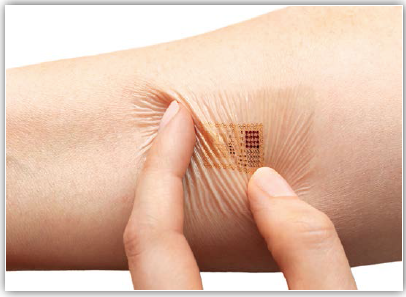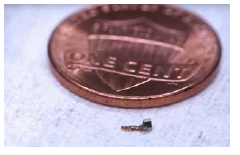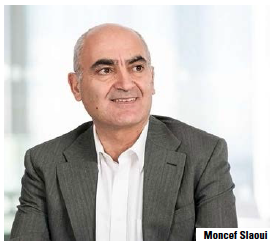Battery-less, Stretchable Patch Provides More Options for Health Monitoring
Trending now: Innovative solutions lead to next generation mHealth tools.
 John Rogers, Ph.D., founder of MC10 and a materials scientist at the University of Illinois at Urbana-Champaign, has introduced a wearable electronic device that wirelessly transmits health data — such as heart rate, blood oxygen level, skin temperature, ultraviolet exposure, and skin color changes — that it is powered by near-field communication (NFC) transmissions from smartphones, tablet computers, and other consumer electronics, making it five to 10 times thinner than comparable gadgets. Dr. Rogers’ achievement has encouraged other university labs to try to develop more uses for the technology.
John Rogers, Ph.D., founder of MC10 and a materials scientist at the University of Illinois at Urbana-Champaign, has introduced a wearable electronic device that wirelessly transmits health data — such as heart rate, blood oxygen level, skin temperature, ultraviolet exposure, and skin color changes — that it is powered by near-field communication (NFC) transmissions from smartphones, tablet computers, and other consumer electronics, making it five to 10 times thinner than comparable gadgets. Dr. Rogers’ achievement has encouraged other university labs to try to develop more uses for the technology.
Dr. Rogers says this is the future of wearables.
There are many applications for ultraflexible electronics, including biodgradable implants and neuroscience research. Dr. Rogers is developing sensors that can be inserted into the skull after brain surgery to monitor pressure and temperature. The devices would naturally dissolve over time, and could one day replace other implants, such as temporary pacemakers.
Neuroscientists hope to use another of Dr. Rogers’s creations, an under-the-scalp device with LED lights, to study brain circuits. By controlling the lights and observing the brain’s reaction, they may better understand certain diseases and psychiatric disorders.
Even sunscreen products are taking advantage of the technology. This summer, La Roche-Posay sunscreen added a complimentary electronics device that sticks to the skin and uses the smartphone to monitor sun exposure in real time.
New Dust-Sized Implants Monitor Internal Health
 Engineers from the University of California, Berkeley, have created dust-sized, wireless sensors that will be key for micro-implants in the body and real-time monitoring of specific nerves, muscles, or organs.
Engineers from the University of California, Berkeley, have created dust-sized, wireless sensors that will be key for micro-implants in the body and real-time monitoring of specific nerves, muscles, or organs.
These sensors, called neural dust, are no more than 3 millimeters long, 1 millimeter high, and 4/5 millimeters thick, allowing them to be easily parked beside a nerve or a muscle fiber. They use ultrasound to both power the sensors and read out their measurements.
Planned upgrades to the sensors include further miniaturization, use of more biocompatible materials, improvement of the transmission and receipt of ultrasounds, and detecting non-electrical substances like oxygen or hormone levels.
Michel Maharbiz, associate professor of electrical engineering and computer sciences, one of the authors of the study published in Neuron Journal, says he believes that long-term prospects for neural dust are not only within nerves and the brain but much broader. Having access to telemetry within the body has never been possible because there has been no way to put something so tiny so deep. But now a tiny speck of electronics can be placed next to a nerve or organ and is able to read out the data.
AstraZeneca Diabetes Support Program Expands to Include Cardiovascular Health
AstraZeneca has extended its free diet and lifestyle support program, Fit2Me, to include resources for patients who face challenges associated with cardiovascular risk and disease. Adults with diabetes are two to four times more likely to have heart disease or a stroke than adults without diabetes. Type 2 diabetes and cardiovascular disease are complex and chronic conditions and maintaining a healthy lifestyle can help people manage their diabetes and reduce cardiovascular risk factors.
 With this addition, Fit2Me now provides consumers with a customized plan tailored to their unique combination of health challenge areas across five of the most prevalent conditions or diseases in the United States, including type 2 diabetes, high cholesterol, heart attack, high blood pressure and high triglycerides. Fit2Me also personalizes each user’s plan to accommodate their food and activity preferences.
With this addition, Fit2Me now provides consumers with a customized plan tailored to their unique combination of health challenge areas across five of the most prevalent conditions or diseases in the United States, including type 2 diabetes, high cholesterol, heart attack, high blood pressure and high triglycerides. Fit2Me also personalizes each user’s plan to accommodate their food and activity preferences.
The additional cardiovascular components differentiate Fit2Me from other support programs and make it one of the only health management tools that allows people to create a customized diet and exercise plan based on food and exercise preferences as well as health challenge areas.
Jim McDermott, VP, U.S. medical affairs, diabetes, AstraZeneca, says: “AstraZeneca recognizes that type 2 diabetes and cardiovascular disease are complex, multi-faceted conditions that affect millions of Americans and require individualized management approaches. By expanding Fit2Me’s offerings to people living with or at risk for cardiovascular disease, we’re able to provide the resources and support needed to help improve the overall health of each patient."
Astellas Launches Digital Health Investment Company
Astellas has joined forces with a US-based life-sciences venture capital firm to form a new digital health investment company. Working with San Francisco’s MPM Capital the company has launched DigiTx Partners, whose interests will include firms that focus on patient outcomes and offer pharma synergies.
 Astellas said its new venture would invest in start-ups and growth-stage companies, but added that its emphasis would be on earlier-stage firms.
Astellas said its new venture would invest in start-ups and growth-stage companies, but added that its emphasis would be on earlier-stage firms.
AstraZeneca Chief Strategy Officer Kenji Yasukawa says, “Exploring unprecedented medical solutions by leveraging Astellas’ strengths in the innovative drug business and integrating these strengths with various medical and healthcare areas is one of the important initiatives of our ‘creating innovation’ strategy as part of Astellas Strategic Plan. Through the investment activities of DigiTx Partners, we will explore the business opportunities in the growing field of digital health and extend our knowledge in the area."
A number of other companies have set up accelerator programs to support emerging companies, such as MSD, Bayer, and Merck.
GSK First Pharma to Use ResearchKit in Study
GSK has applied more than 40 technologies to a range of studies and the latest is the Patient Rheumatoid Arthritis Data from the Real World (PARADE) study, which uses an iPhone app built by GSK using Apple’s ResearchKit. ResearchKit is a software framework designed specifically for medical research that helps doctors and scientists gather data more frequently and more accurately from participants using an iPhone. GSK was the first in the industry to use Apple’s ResearchKit as part of research, this time looking at the impact a patient’s disease has on their day-to-day life. The study will use the GSK PARADE iPhone app to conduct surveys and use iPhone sensors to collect and track common symptoms of rheumatoid arthritis: joint pain, fatigue, and mood. It will also track activity and quality of life measures for 300 patients over a three-month period.
The app, powered by Medidata and Possible Mobile, creates a secure environment for patient data. Patients using the PARADE app have access to a dashboard containing their personal data in the study, which they’ll also be able to share with their healthcare providers to support conversations about treatment plans.
GSK and Verily launch Galvani Bioelectronics
GlaxoSmithKline has joined with Verily Life Sciences to set up Galvani Bioelectronics, which will focus on treating chronic illnesses by controlling electrical impulses in the body. GSK and Verily, the former Google Life Sciences business, will initially invest up to $718 million over seven years to support R&D at Galvani.
Galvani will combine GSK’s capabilities with Verily’s technical expertise in miniaturizing low-power electronics and in developing implantable devices, data analytics, and software for clinical applications. Galvani will initially employ about 30 scientists, engineers, and clinicians.
Although neurostimulators are available to treat epilepsy, pain, and other conditions, GSK envisions much tinier devices attached directly to nerves. These devices will be designed with better clinical insight and more precise neural control, the company claims. Ultimately, the goal is to close the therapeutic loop by having devices that can measure conditions, analyze data, and adjust treatment as needed.
Moncef Slaoui, GSK’s chairman of global vaccines, who was instrumental in establishing GSK’s investments in the field of bioelectronics, will chair the board of the new company.
“Many of the processes of the human body are controlled by electrical signals firing between the nervous system and the body’s organs, which may become distorted in many chronic diseases," Dr. Moncef says. “Bioelectronic medicine’s vision is to employ the latest advances in biology and technology to interpret this electrical conversation and to correct the irregular patterns found in disease states, using miniaturized devices attached to individual nerves. If successful, this approach offers the potential for a new therapeutic modality alongside traditional medicines and vaccines."
EHRs Trends and Growth
The research firm Technavio is forecasting the global EHR market to grow at a compound annual growth rate (CAGR) of more than 5%, exceeding $28 billion by 2020.
Wearables and other health and fitness devices used by patients represent another area of growth for EHR and healthcare applications.
Connecting these devices with patient electronic health records could allow doctors and other medical providers to access health data including heart rate, glucose level, and cholesterol levels. Using the information gathered, doctors will have the most recent and relevant information about the patient in order to prepare electronic prescriptions based on the information gathered.
Technavio identified three big trends that are impacting the market and driving the growth of EHR:
Increased adoption of predictive analytics
Proliferation of health and fitness device and application
Integration of telemedicine and EHR is on the rise
In the case of the proliferation of health and fitness device and application, the healthcare industry is perceiving significant growth in healthcare applications that can be accessed on mobile or tablet devices. Leading companies such as Apple, Samsung, and Google have developed several health and fitness applications and devices. Apple has developed a cloud-based platform called HealthKit that stores an individual’s health information such as blood pressure, heart rate, and weight with the help of a third-party application provider, Nike. Apple also partnered with Mayo Clinic and other hospitals to access patient’s health information. (PV)










